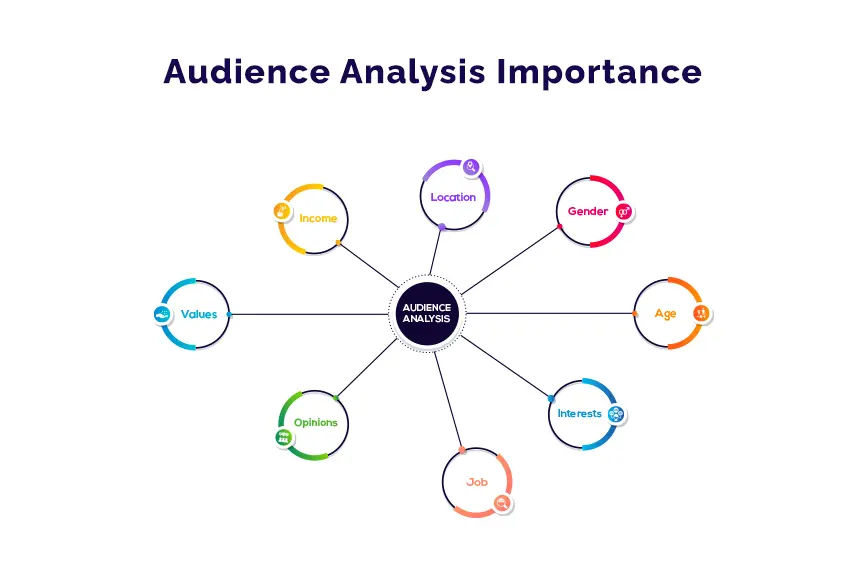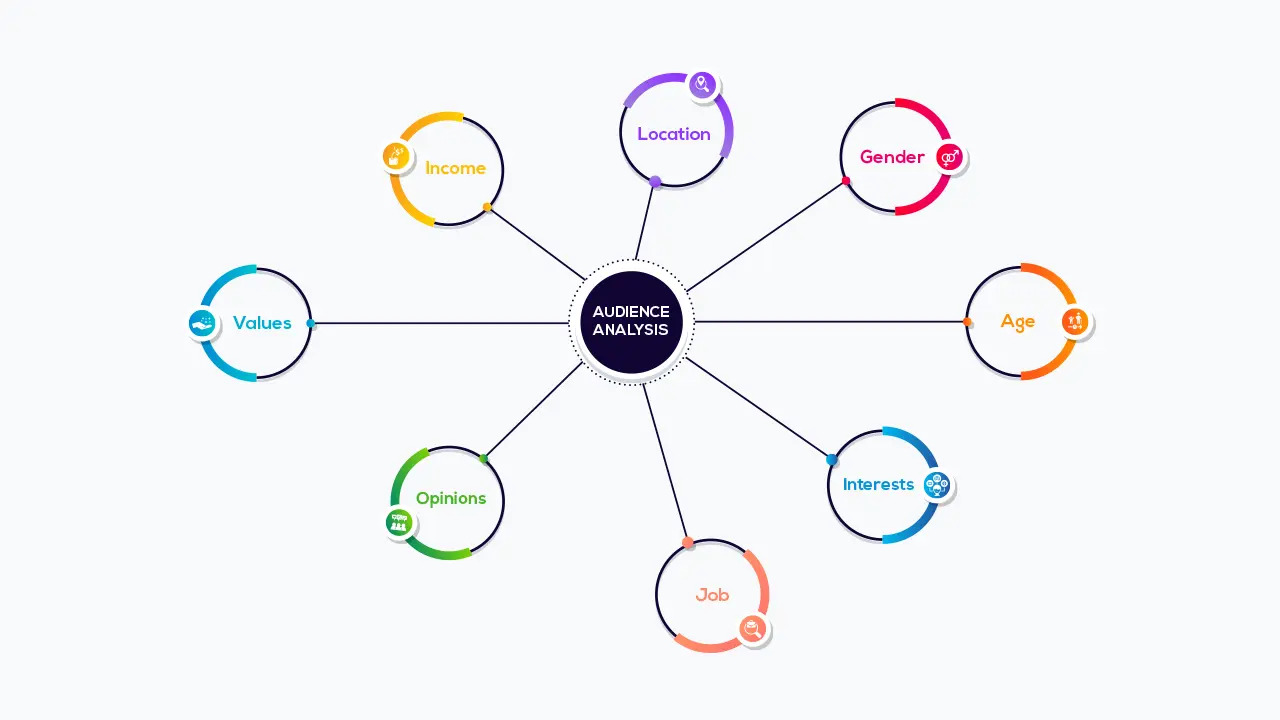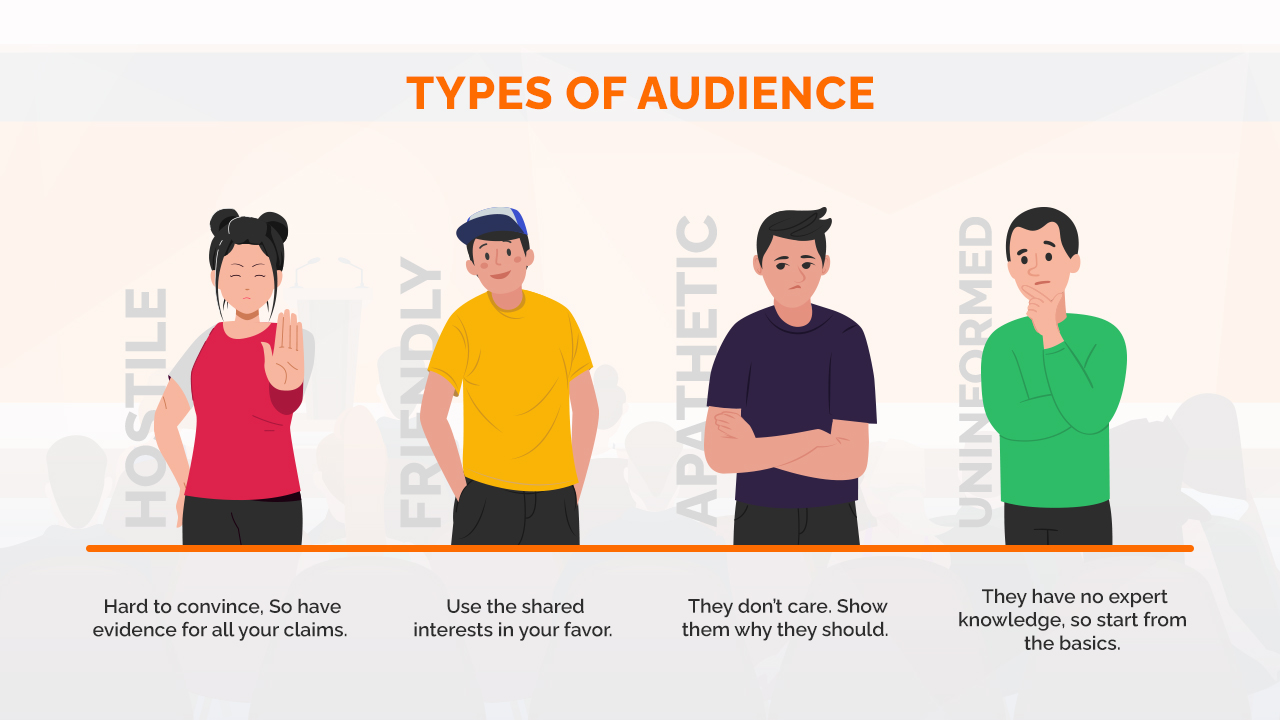Audience Analysis for Presentations: How to know your audience and present better

If you are in any business or public speaking domain, you must have heard of the term audience analysis. If you’ve ever given a talk where half of the people seem disinterested or distracted, it’s probably because you’ve overlooked the importance of audience analysis.
It’s high time to rethink about how to prepare a presentation. It’s always about the audience, so let’s start there. Celebrated speakers and leaders in history knew what their audience wanted and they used it to form an instant and prolonged connection with the mass. Though each person is different with their own perceptions and views, your job as a speaker is to find that common thread that connects all of them, and align your presentation along those lines.
In this article, we will take you through simple steps to know your audience and how you can use it to deliver better presentations, form better connections and impart values to your audience. You can also create better presentations in minutes with these PowerPoint templates from SlideBazaar!
What is Audience Analysis?
It always helps to know who you are speaking to and why they are listening to you. Audience analysis refers to the gathering of information about your audience to form a generalized opinion, and then using the data to weave your presentation well. This involves planning your presentation for the audience by adapting to their understanding, values and interests. In any form of public speaking, audience is of utmost importance and catering to their needs is what sets a great speaker apart from the rest.
It’s difficult to make assumptions about someone you’ve just met. But there are audience analysis techniques you can use to identify the subtle traits which may give you a better idea of what they want. In further sections, we will discuss which of these should be considered in the analysis of your audience along with tips to incorporate them into your presentations.
Why is audience analysis important?
1. Knowing your audience helps you speak their language and gain their trust
Audience analysis makes it easier to form a connection with the audience since you already know what they are looking for. Effective communication is about both speaker and audience being in sync in terms of their motives and actions. And the better you know the audience, the more both parties will benefit from the interaction. You can build trust among your target audience by addressing the pain points and suggesting tangible solutions.
2. Understanding their behavioral patterns helps you to persuade them to take desired actions
Knowing the values of your target audience gives you a window into knowing how they make a decision. This is very crucial because you never know when you might stumble upon a business opportunity or a potential collaboration. If your presentation is meant to educate the crowd or promote your service or to get a sale, knowing the behavioral patterns of your target audience will help you give a more compelling presentation. Some look for ways to save money and time, while some spend more time and prefer quality over quantity. Addressing them in your presentation is a promising way to get them on board.
3. Audience adaptation helps you be sensitive to their needs and expectations
By knowing more about the target audience, you can estimate how receptive they would be to different segments of your speech. Audience analysis helps you realize what emotions may trigger, offend and how to persuade them. You develop a better understanding of do’s and don’ts to follow in the presentation. You can choose the tone, analogies, jokes and call to action in a more audience-centric way, and this will create further impact on your audience.
How to know your audience?
At this point, you are convinced you should know your audience for delivering better presentations. But you must be wondering what you should look for in a group of people you’ve just met. Here are some factors which you can take a note of to make better assumptions about the audience.

1. Audience Demographics
Demographics refers to the statistical characteristics of a group such as age, gender identity, education, occupation, ethnicity, financial and marital status. Age and education level are very important since it highly influences how the information would be consumed. Dumbing down your audience will leave them distracted since they won’t benefit from your presentation. Similarly, overestimating their level of information intake will leave them exhausted. According to their background, there will be different angles of the same topic people will be interested in. Knowing the details in advance will help you prepare the presentation accordingly.
2. Knowledge of Topic
It’s very important to understand what prior knowledge the audience possesses regarding the subject. It determines how you should start your talk. If you’re talking to amateurs, you should probably start with a simple introduction of the topic along with its significance so that they feel interested in listening to you. If you’re talking to experts, you can jump into the topic and talk about more technicalities since you already have them on board. Understanding their experience and training in the topic can help you streamline your presentation. You can decide whether to use jargons or to use more broad examples during your talk.
3. Audience Size and Setting
The way you talk to a class of ten students is very different from the way you talk to a room of 300 business owners. Your speech at a funeral would be different from that at a wedding. So, it’s important to know how many people you will be addressing, and in what context. Will it be a closed room or an open stage? Would there be provision to include audiovisual tools (e.g., slides) or do you have to prepare a full-on speech? Knowing the size of your crowd will help you accommodate the right amount of interaction so that the conversation is lively and engaging.
Make sure you know what time of the day you will be speaking because people have different attention levels in the morning and late afternoon.
4. Values and Beliefs
Religious inclination, cultural backgrounds and general upbringing have a huge role in shaping how open people accept a new idea. Some might be reluctant to accept them unless they are convinced that it aligns with their system of belief. Consider the possibility of having people with different beliefs and value systems. You should take effort to not offend anyone. Try to understand their ideologies to fine tune your speech so that it’s not insensitive or distracting.
5. Means of Consuming Information
Where do your audience typically consume information from? Do they consume it online or do they resort to textbooks? Do they attend similar workshops and update themselves with the current trends? Are they regularly interacting with experts in the field or included in the studies themselves? All these matters when it comes to deciding how you should pass the information on. If they prefer discussions, you can include a lot of engaging activities. If they like to have capsules of information, you can include the main points in bullets before loading them with details.
Types of audience and how to deal with them

Based on the above-mentioned aspects, people respond differently to you. In this section, we look at different types of audience and ways to handle them.
Some might be reluctant to change their ways of thinking and you might need strong logical reasons to convince them. Some might be volunteers who readily accept a new idea and are ready to take the action you want them to take. Some might be the drivers of decision making in a group where they cut across distractions and ensure the promise is delivered.
1. Hostile audience: They are hard to convince, so have evidence for all your claims.
These are the egocentric people who question your claims and defend their views. The fact that audience is egocentric means that they are less open to new perspectives and ideas. When you spot such people in a crowd, don’t panic.
Listen to what they have to say and stress on the common points you share. This feeds their ego and can work well to have them on board with you. Don’t exaggerate or drag your points since they may distract or even offend them. Have clear and concise data for all your claims and present your conclusions in a compelling way.
2. Friendly audience: Use the shared interests in your favor.
There might be some people who are already excited about the topic and are willing to hear from you. They resonate with your ideas and support you throughout your presentation.
Talk to them passionately and tap into their emotions by using analogies or models similar to them. Friendly audience are the most loyal and easiest to convince. So, tell them what exactly to do, be it purchasing your product or signing up for your newsletter.
3. Apathetic audience: They don’t care, show them why they should.
This is the section of people who care least about what you have to offer. They have no interest to argue or discuss. They may zone out from time to time and are probably waiting for you to stop talking.
The first step is to make them a part of the conversation. Ask simple questions and be patient while they answer. Use interesting visuals to gauge their interest. Slowly bring them to your subject through strong points and show them why they should care. Don’t show off your skills, instead focus on what’s in it for them.
4. Uninformed audience: They have no expert knowledge, so start from the basics.
These are the people who have come to learn a deep understanding of the subject. They might have a very vague understanding of the topic and want to learn more. They are looking for someone who can explain to them in basic terms.
So, before you dive in, ask them what they know and start with basic examples and applications. Take time to teach them before persuading them to take an action. You want to avoid jargons or any terms which might be heavy for this section of audience.
Most crowds have most if not all kinds of personalities; so, prepare your presentation to fit all of them well.
Follow these steps in your next presentation
You have done a complete audience analysis and now you know what they expect from your presentation. How will you use that data in your favor? What changes will you make to your presentation? These bits of information are useful only when you know what to do with the data. Here are some steps you can follow to put audience analysis data into use.
1. Practice audience-centeredness in your presentation
Always remember to put the audience first. Tell them what’s in it for them. Actively ask them what they expect from your presentation. If you’re teaching a new concept to the crowd, tell them where they can apply it in real life. If you’re selling a product, show them the benefits of the service rather than the features. If you’re a researcher, tell them how your studies change the current scenario of the domain and how that will impact them. Be sure to choose the examples wisely.
2. Find a common ground
No two people have the same opinion or perception of things. It’s impossible to deliver exactly what your audience want and in the exact way they want. But, it’s wise to find a common ground where you include the audience without deflecting from your values and objectives. It doesn’t mean you should change the presentation fully to fit the audience’s wants; you will lose your authenticity. However, if you’re adamant about your views and delivery, people will perceive you aggressive and wouldn’t want to listen to you. This also helps in addressing each type of audience well.
3. Create audience personas and practice
Based on your best assumptions, create a persona of your target audience and keep that in mind while practicing your presentation. Humans love undivided attention; everyone in the audience should feel like you’re speaking to them individually. Having a characteristic persona helps you devise techniques to address them. You can use the demographic details and their expectations of the subject to create a persona. Apart from presentations, you can also use this in business proposals to convey your message in the intended way.
4. Identify their pain points and address them in your presentation
Once you know what your audience expects and what their pain points are, you can then decide how to talk to them. Address their problems and give possible solutions. Convince them what you have to offer can solve the problems for them. Use tools like answerthepublic.com to know what are the common queries related to your topic. And draft your presentation to answer those questions in the best way possible such as to promote your product/service. This way, it will be easier to get them to take the desired action.
5. Go for audience segmentation if needed
If you think it’s better to divide the audience into different groups and approach them differently, do that. There can be topics that are relevant to different types of audience. Use the audience analysis data to identify and segregate potential groups in the audience. Doing this can help both the speaker and the audience since both don’t have to compromise much.
Conclusion
We have given you the tools and tricks to know what your audience wants and now it’s up to you to put into use. To help you with that, we have different presentation templates that will make it easier for your audience to receive the message better. If you’re looking for opportunities to incorporate audience analysis into your presentations more effectively, we have audience analysis templates exclusively designed for that.
Happy presenting!

